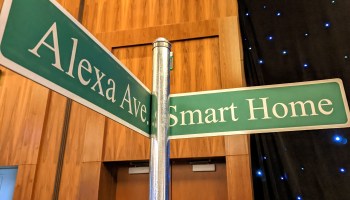
It was tough, as usual, to keep up with the announcements coming out of Amazon’s fall Devices & Services event Wednesday morning. But in a change from the past, there was lot more stage time for software enhancements, AI features, and paid subscription services, and not as much focus on new Echo devices.
Put another way, there was no Alexa-enabled microwave anywhere to be found.
The shift suggests a sharper focus in the Alexa and Echo division after a difficult year that included cutbacks as part of a broader shakeout in Amazon’s corporate and technology workforce. Dave Limp, the longtime leader of the division, led its signature annual event for the final time after previously announcing plans to retire.
There was no cameo by Panos Panay, the former Microsoft Surface leader who was reported by Bloomberg News this week to be in line to succeed Limp as the new head of the Amazon Devices & Services division.
There was still plenty of new hardware, including a wall-mountable Echo Hub designed to serve as a smart-home control panel; an upgraded Echo Show 8; a Fire TV Soundbar; and new releases from Amazon’s Ring, Blink and eero.
But from the start, the tech giant was clearly out to make a statement about artificial intelligence, attempting to counter the impression that it has fallen behind OpenAI and others in the field.
It began with a preview of its new “Let’s Chat” feature that turns Alexa into something more closely resembling a voice-enabled ChatGPT.
Limp made it clear that Amazon doesn’t consider the comparison to ChatGPT fair, citing the unique requirements of voice interactions in the home, including a need for much faster responses than available in text interactions, and zero tolerance among users for AI hallucinations when trying to turn off a lightbulb, for example.
“We’ve been on that journey to create that superhuman assistant for more than a decade now,” Limp said in his introductory remarks from Amazon’s HQ2 in Arlington, Va. “But with generative AI, it’s now within reach.”
As demonstrated on stage, the feature opens a dedicated session that allows users to converse with Alexa and even interrupt the voice assistant without repeatedly invoking a wake word. Alexa maintains the context of the conversation over time, until the user ends the session, and takes into account preferences such as a favorite sports team.
Amazon also showed this video to give a sense for the capabilities.
An optional capability works in conjunction with Amazon’s visual ID service, allowing enrolled users to start and maintain a conversation with Alexa by looking at the screen without saying “Alexa,” said Rohit Prasad, Amazon’s senior vice president and head scientist of Artificial General Intelligence.
“This is the most natural conversational experience we have built,” Prasad said. “And it feels just like talking to a human being because it has the same latency as you expect when talking to a human.”
Prasad also previewed a new version of Alexa that will adjust its tone and emotion based on the context of a conversation, such as informing you that your favorite sports team has lost a game.
Other new capabilities announced and previewed by Amazon at the event:
- The future ability to speak conversationally to control smart-home devices, giving Alexa instructions for multiple steps at once, rather than one-by-one.
- A new smartphone feature called Map View, giving customers an overview of their Alexa devices on a diagram of their home.
- Alexa Emergency Assist, a voice-enabled personal and family safety service, will be $5.99 a month or $59 a year.
- A feature called Eye Gaze for the Fire Max 11 tablet, for people with mobility or speech disabilities to use Alexa with their eyes.



